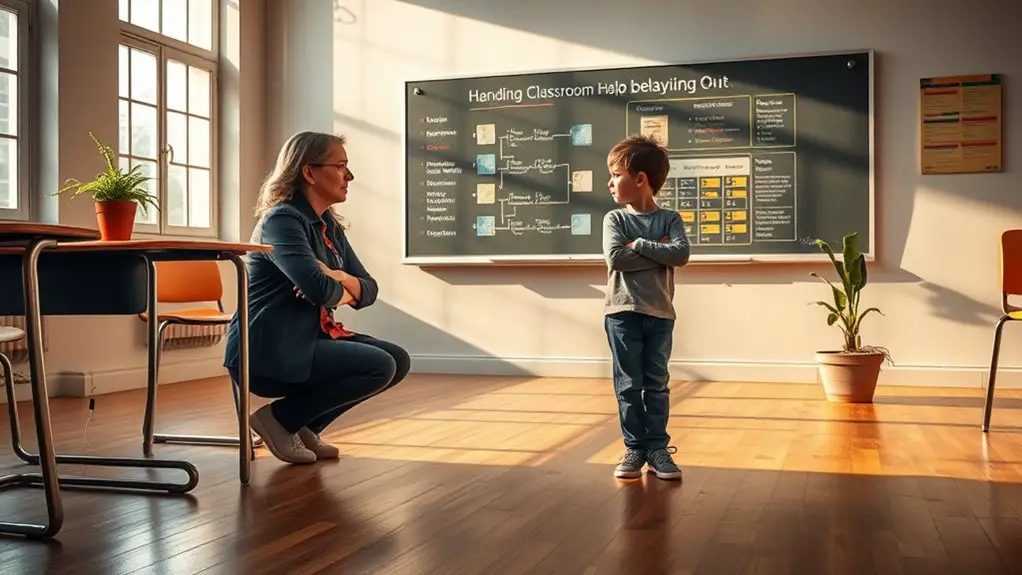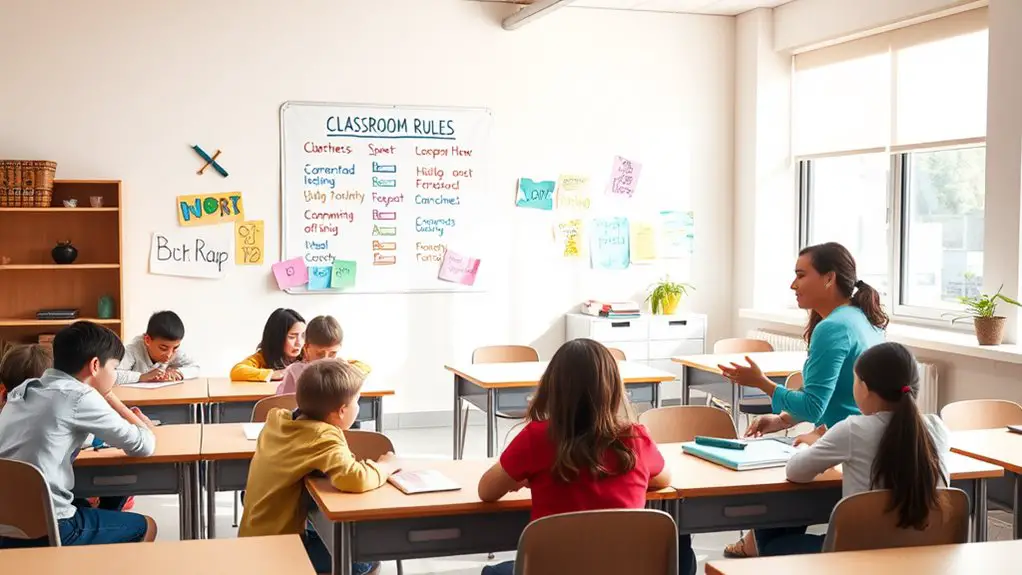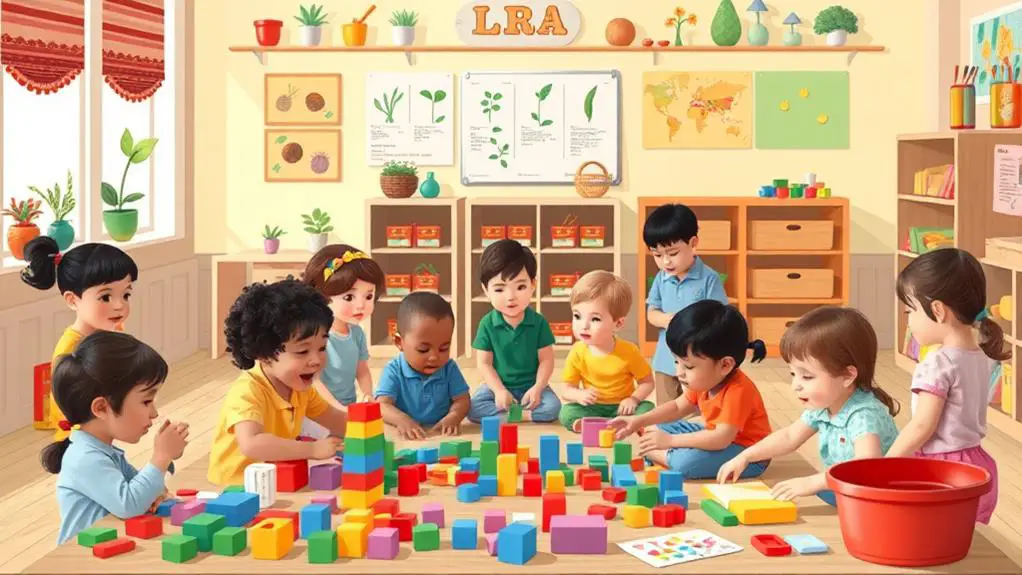The classroom is a society of students. And just like any other society, it is argued that there must be rules and regulations for its successful operation.
As teachers, our main goal is to create a classroom full of responsible students.
That makes the class an effective place for effective teaching and learning to take place.
If you have been wondering why and how classroom rules are important, this article will help answer your questions.
What Are Classroom Rules?
Classroom rules are regulations that tell students what they are allowed or not allowed to do.
Classroom rules ensure the successful functioning of the environment of each class if created and implemented appropriately.
Most teachers and education experts encourage teachers to set rules and regulations to guide everyone’s behavior on the first day of the class.
That is considered the best if the teacher wants the rules to be effective.
How Are Classroom Rules Necessary?
If you type classroom rules into Google, there will be lots of results on the best rules for various class levels and how to set them.
However, less is mentioned about why it is imperative to have rules in the classroom.
The following are some of the reasons why classroom rules are important:
Maintaining order
Maintaining order in the classroom is essential for creating a productive and focused learning environment. Classroom rules play a crucial role in ensuring that there is a sense of structure and organization. By establishing clear guidelines for behavior and expectations, students are able to navigate through different activities smoothly, without unnecessary disruptions.
When there are well-defined rules in place, students know what is expected of them and how to conduct themselves in the classroom. This promotes a sense of order and discipline, which is essential for effective teaching and learning. Students are able to transition between tasks seamlessly, without wasting time or causing distractions.
Moreover, maintaining order through classroom rules helps to create a sense of fairness and equality among students. When everyone understands and follows the same set of rules, it ensures that all students have an equal opportunity to learn and participate. This fosters a positive and inclusive learning environment where every student feels valued and respected.
By emphasizing the importance of maintaining order, students also learn valuable life skills such as self-discipline and time management. These skills are transferable beyond the classroom and can benefit them in various aspects of their lives.
In summary, classroom rules are crucial for maintaining order and structure in the learning environment. They facilitate smooth transitions, minimize disruptions, promote fairness, and teach valuable life skills. By adhering to these rules, students are able to create a conducive atmosphere for effective teaching and learning.
Promoting respect
Promoting respect is another important aspect of classroom rules. Through these rules, students learn to respect their peers, teachers, and the learning process itself. One of the key ways in which respect is fostered is by teaching students to listen to one another. By establishing rules that encourage active listening, such as raising hands and waiting for their turn to speak, students learn to value each other’s opinions and perspectives.
In addition, classroom rules teach students the importance of taking turns. By implementing rules that promote equal participation, such as taking turns during group discussions or sharing materials, students learn to respect each other’s right to contribute and be heard. This not only creates a more inclusive learning environment but also helps students develop empathy and understanding towards their peers.
Furthermore, classroom rules also emphasize the importance of respecting teachers. By establishing guidelines for appropriate behavior towards teachers, such as using respectful language and following instructions, students learn to value the authority and expertise of their educators. This fosters a positive teacher-student relationship and creates a conducive learning environment.
Overall, promoting respect through classroom rules helps students develop important social skills and values. They learn to listen attentively, take turns, and value the opinions and perspectives of others. By instilling these values early on, students are better equipped to navigate social interactions and contribute positively to their communities.
Fostering responsibility
Fostering responsibility is another crucial aspect of classroom rules. By establishing clear guidelines and expectations, rules instill a sense of responsibility in students. They learn to be accountable for their actions and understand the consequences of their choices. This fosters a culture of personal responsibility and empowers students to take ownership of their learning and behavior.
One way in which rules foster responsibility is by setting clear boundaries. When students know what is expected of them, they are more likely to make responsible choices. For example, rules that outline the appropriate use of technology in the classroom help students understand the importance of using devices responsibly and avoiding distractions. By adhering to these rules, students develop self-discipline and learn to prioritize their learning over other distractions.
Furthermore, classroom rules also teach students the importance of following through on commitments. By establishing rules that require students to complete assignments on time and come prepared to class, they learn the value of meeting deadlines and being responsible for their own learning. This not only prepares them for future academic and professional endeavors but also helps them develop a strong work ethic.
In summary, fostering responsibility through classroom rules is essential for students’ personal and academic growth. By setting clear boundaries and expectations, rules empower students to make responsible choices, develop self-discipline, and take ownership of their learning. These skills and values will benefit them not only in the classroom but also in their future endeavors.
Enhancing focus
Enhancing focus is a crucial aspect of classroom rules. Clear rules help students stay focused on their tasks and reduce distractions, enabling them to engage fully in their learning and achieve better academic outcomes. By establishing guidelines for behavior and expectations, rules create a structured environment that promotes concentration and minimizes disruptions.
One way in which rules enhance focus is by setting boundaries for technology use. For example, rules that restrict the use of personal devices during class time help students avoid distractions and stay focused on the lesson. By adhering to these rules, students are able to fully engage with the material being taught and participate actively in class discussions.
Additionally, rules that establish guidelines for classroom behavior also contribute to enhancing focus. When students know what is expected of them in terms of behavior and participation, they are more likely to stay on task and avoid distractions. By creating a safe and respectful learning environment, rules enable students to concentrate on their work and make the most of their educational experience.
In summary, enhancing focus through classroom rules is essential for creating an environment conducive to learning. By setting clear boundaries and expectations, rules help students minimize distractions and fully engage in their academic pursuits. This ultimately leads to improved concentration, better academic outcomes, and a more productive learning environment.
Creating a safe environment
Creating a safe environment is a fundamental aspect of classroom rules. These rules play a crucial role in ensuring the safety and well-being of students, both physically and emotionally. By establishing guidelines for behavior and conduct, rules provide a framework that promotes a safe and secure learning environment.
One important aspect of creating a safe environment is setting guidelines for physical safety. Rules that outline proper procedures for handling equipment, using tools, or participating in physical activities help prevent accidents and injuries. By adhering to these rules, students learn to prioritize their safety and the safety of others, fostering a culture of responsibility and awareness.
In addition to physical safety, rules also contribute to emotional and psychological security. Guidelines for respectful communication, conflict resolution, and anti-bullying policies create an atmosphere of respect and empathy. Students feel safe expressing their thoughts and ideas, knowing that they will be heard and valued. This sense of emotional security allows students to fully engage in their learning without fear of judgment or mistreatment.
By creating a safe environment through classroom rules, students can focus on their academic pursuits without distractions or concerns for their well-being. This promotes a positive and nurturing atmosphere where students can thrive and reach their full potential. Ultimately, a safe environment fosters a sense of belonging and trust, enabling students to develop holistically and succeed academically.
Encouraging teamwork
Encouraging teamwork is another important aspect of classroom rules. By establishing guidelines that promote collaboration and cooperation, students learn the value of working together towards a common goal. This fosters a sense of unity and camaraderie among students, creating a positive and supportive learning environment.
One way classroom rules encourage teamwork is by emphasizing the importance of respecting others’ ideas. Rules that promote active listening, constructive feedback, and open-mindedness help students appreciate the diverse perspectives and contributions of their peers. This not only enhances their understanding of different viewpoints but also encourages them to consider alternative solutions and approaches.
Furthermore, classroom rules provide opportunities for students to engage in group activities and projects. By working in teams, students learn to communicate effectively, delegate tasks, and collaborate towards a shared objective. This not only enhances their interpersonal skills but also teaches them the value of collective effort and the benefits of pooling their strengths and abilities.
Through teamwork, students also develop important life skills such as leadership, compromise, and conflict resolution. Classroom rules that encourage collaboration provide a platform for students to practice these skills in a safe and supportive environment. This prepares them for future endeavors where teamwork and cooperation are essential for success.
In conclusion, classroom rules play a vital role in fostering teamwork and collaboration among students. By promoting respect for others’ ideas, providing opportunities for group work, and developing important life skills, these rules create a foundation for students to thrive both academically and socially.
Developing self-discipline
Developing self-discipline is another crucial aspect of classroom rules. By adhering to these rules, students cultivate the ability to exercise self-control and regulate their behavior. Classroom rules provide a framework for students to develop self-discipline by setting clear expectations and boundaries.
One way classroom rules foster self-discipline is by encouraging students to set goals. Rules that promote goal-setting help students identify what they want to achieve and create a plan to reach their objectives. This not only teaches them the importance of self-motivation but also instills a sense of responsibility and determination.
Moreover, classroom rules help students manage their time effectively. Rules that establish routines and schedules enable students to prioritize their tasks and allocate their time wisely. This teaches them the value of time management and helps them develop the skills necessary to meet deadlines and complete assignments efficiently.
By following classroom rules, students also learn the importance of accountability. Rules that hold students responsible for their actions and behaviors teach them to take ownership of their choices. This cultivates self-discipline by encouraging students to think before they act and consider the consequences of their decisions.
In summary, classroom rules play a vital role in developing self-discipline among students. By promoting goal-setting, time management, and accountability, these rules empower students to take control of their actions and behaviors. This not only benefits them academically but also prepares them for future challenges where self-discipline is essential for success.
Cultivating good habits
Cultivating good habits is another significant benefit of classroom rules. Through these rules, students are able to develop and internalize important habits that contribute to their overall success. One key habit that classroom rules help to cultivate is punctuality. By setting expectations for students to arrive on time, they learn the importance of being prompt and respecting others’ time. This habit of punctuality extends beyond the classroom and prepares students for future commitments and responsibilities.
In addition to punctuality, classroom rules also promote organization. Rules that encourage students to keep their materials and workspace organized teach them the value of being prepared and efficient. By developing this habit of organization, students are better equipped to manage their tasks and responsibilities, both inside and outside the classroom.
Furthermore, classroom rules play a role in maintaining cleanliness. Rules that emphasize the importance of cleanliness and tidiness in the learning space help students understand the significance of taking care of their environment. This habit of cleanliness not only creates a pleasant and conducive learning environment but also instills a sense of responsibility and respect for shared spaces.
By inculcating good habits such as punctuality, organization, and cleanliness, classroom rules contribute to the holistic development of students. These habits not only benefit them academically but also prepare them for future endeavors where discipline and good habits are essential for success.
Enhancing social skills
Classroom rules play a crucial role in enhancing students’ social skills. By establishing clear expectations and guidelines, rules encourage students to interact positively with their peers. One important aspect of social skills that classroom rules promote is effective communication. Through rules that encourage respectful and constructive communication, students learn how to express their thoughts and ideas clearly and listen actively to others. This skill not only helps them in the classroom but also in their future personal and professional relationships.
In addition to communication, classroom rules also provide opportunities for students to learn conflict resolution skills. Rules that promote peaceful and respectful ways of resolving conflicts teach students how to handle disagreements in a fair and considerate manner. These skills are essential for building healthy relationships and fostering a positive classroom environment.
Moreover, classroom rules create a structured setting where students can practice teamwork and collaboration. Rules that require students to work together on group projects or assignments help them develop skills such as cooperation, compromise, and problem-solving. These skills are valuable not only in the classroom but also in various aspects of their lives, including future careers.
By enhancing social skills through effective communication, conflict resolution, and teamwork, classroom rules contribute to the overall development of students. These skills enable them to navigate social situations, build healthy relationships, and thrive in a collaborative and interconnected world.
Improving concentration
Establishing and enforcing classroom rules is essential for improving students’ concentration. When students know what is expected of them, they can concentrate on their learning without worrying about the consequences of misbehaving. This creates a focused and productive learning environment.
One way classroom rules enhance concentration is by minimizing distractions. Rules that prohibit disruptive behaviors such as talking out of turn, using electronic devices, or engaging in off-task activities help students stay focused on their work. Setting clear boundaries and rules creates a structured environment that promotes concentration and minimizes distractions.
Additionally, classroom rules can also promote time management skills, which are crucial for maintaining focus. Rules that establish deadlines for assignments and encourage students to manage their time effectively teach them how to prioritize tasks and allocate their attention accordingly. This helps students develop the ability to concentrate on one task at a time and avoid procrastination.
Furthermore, rules that promote active listening and participation also contribute to improved concentration. By encouraging students to listen attentively to their peers and actively engage in discussions, rules foster an environment where students are fully present and engaged in the learning process. This active involvement enhances concentration and promotes a deeper understanding of the subject matter.
In conclusion, classroom rules play a vital role in improving students’ concentration. By minimizing distractions, promoting time management skills, and encouraging active participation, rules create an environment that supports focused learning and enhances students’ ability to concentrate on their academic tasks.
Encouraging active participation
Encouraging active participation is another important aspect of classroom rules. By establishing clear guidelines for classroom interactions, rules create an environment that fosters active engagement and participation among students. When students know that their ideas and questions are valued and respected, they feel more comfortable expressing themselves and actively participating in class discussions.
One way that rules promote active participation is by encouraging students to take turns and listen attentively to their peers. Rules that establish guidelines for respectful communication, such as raising hands to speak and actively listening without interrupting, create a space where every student has the opportunity to contribute and be heard. This not only enhances active participation but also promotes a sense of inclusivity and respect among students.
Furthermore, rules that promote collaboration and teamwork also contribute to active participation. By establishing expectations for group work and encouraging students to work together on projects and assignments, rules foster a collaborative learning environment. This encourages students to actively engage with their peers, share ideas, and contribute to the collective learning experience.
In conclusion, classroom rules play a crucial role in encouraging active participation. By creating an environment where students feel comfortable expressing their ideas, asking questions, and engaging in discussions, rules promote active engagement and enhance the overall learning experience. Through respectful communication and collaboration, rules foster a sense of inclusivity and teamwork, allowing students to actively participate and contribute to their own learning and the learning of their peers.
Instilling fairness
Instilling fairness is another important aspect of classroom rules. By establishing clear guidelines and expectations, rules teach students about fairness and equity. Students learn that rules apply to everyone equally, ensuring a level playing field for all.
One way that rules promote fairness is by setting clear consequences for breaking the rules. When students understand that there are consequences for their actions, they are more likely to think twice before engaging in unfair behavior. This helps to create a sense of fairness and accountability within the classroom.
Additionally, rules that promote fairness also establish guidelines for sharing resources and opportunities. For example, rules may outline how materials should be shared, how group work should be divided, or how speaking time should be allocated. By ensuring that everyone has equal access to resources and opportunities, rules foster a sense of fairness and prevent any one student from dominating or monopolizing the classroom environment.
Furthermore, rules that promote fairness also encourage students to treat each other with respect and kindness. By establishing expectations for respectful behavior and discouraging bullying or discrimination, rules create a safe and inclusive environment where all students feel valued and respected.
In summary, classroom rules play a crucial role in instilling fairness. By teaching students about fairness and equity, setting clear consequences, promoting equal access to resources and opportunities, and encouraging respectful behavior, rules create a fair and inclusive learning environment for all students.
Building a sense of community
Building a sense of community is a fundamental aspect of classroom rules. By establishing clear expectations and guidelines, rules create an environment where students feel a sense of belonging and community. This sense of community is crucial for fostering positive relationships among students and promoting a supportive learning environment.
When students follow classroom rules, they feel valued, respected, and accepted. They understand that their contributions are important and that their voices are heard. This sense of belonging increases their engagement in the learning process and encourages them to actively participate in class activities and discussions.
Moreover, classroom rules also promote collaboration and teamwork. By setting guidelines for group work and cooperation, rules encourage students to work together towards common goals. This not only enhances their social skills but also helps them develop important life skills such as communication, problem-solving, and compromise.
In addition, rules that promote a sense of community also discourage negative behaviors such as bullying or exclusion. By establishing expectations for respectful and inclusive behavior, rules create a safe and supportive environment where all students can thrive.
Overall, classroom rules play a vital role in building a sense of community. They create an atmosphere of belonging, respect, and acceptance, which fosters positive relationships, enhances student engagement, and promotes collaboration and teamwork. By nurturing a strong sense of community, classroom rules contribute to a positive and enriching learning experience for all students.
Promoting self-confidence
Promoting self-confidence is another important aspect of classroom rules. When students follow the established rules, they experience a sense of accomplishment and build self-confidence. This positive reinforcement not only boosts their self-esteem but also contributes to their overall well-being and academic success.
By adhering to classroom rules, students develop a sense of competence and mastery. They understand that they have the ability to meet expectations and succeed in their tasks. This sense of achievement fosters a belief in their own abilities and encourages them to take on new challenges with confidence.
Moreover, classroom rules provide a framework for students to set goals and work towards achieving them. When they see the direct correlation between following the rules and achieving their desired outcomes, they become more motivated and driven to excel. This motivation further enhances their self-confidence and empowers them to strive for success in all areas of their academic journey.
In addition, when students consistently follow classroom rules, they earn the respect and trust of their peers and teachers. This positive recognition further boosts their self-confidence and reinforces their belief in their own abilities. They feel valued and appreciated for their responsible behavior, which in turn encourages them to continue making positive choices.
Overall, promoting self-confidence through classroom rules is essential for students’ personal and academic growth. By providing a supportive and structured environment, rules empower students to believe in themselves, set goals, and strive for success. This self-confidence will not only benefit them in the classroom but also in their future endeavors.
Preparing for the future
Classroom rules not only provide structure and guidance within the classroom, but they also play a crucial role in preparing students for the future. By adhering to these rules, students learn important life skills that will benefit them beyond the classroom.
One key skill that students develop through classroom rules is the ability to navigate rules and regulations. In the real world, there are rules and regulations in various settings such as workplaces, communities, and even personal relationships. By understanding and following classroom rules, students learn the importance of compliance and develop the skills to navigate and adapt to different rules and expectations.
Classroom rules also help students understand boundaries. They learn that there are limits to their behavior and actions and that respecting these boundaries is essential for maintaining a harmonious environment. This understanding of boundaries translates into their future interactions with others, helping them establish healthy relationships and navigate social situations effectively.
Moreover, classroom rules teach students to act responsibly. They learn that their actions have consequences and that they are accountable for their behavior. This sense of responsibility carries over into their future endeavors, whether it be in their personal lives or professional careers. Students who have internalized the importance of responsibility are more likely to make ethical decisions and take ownership of their actions.
In conclusion, classroom rules are not just about maintaining order within the classroom. They provide students with valuable life skills that will prepare them for the future. By teaching them how to navigate rules, understand boundaries, and act responsibly, classroom rules empower students to become responsible, respectful, and successful individuals in all aspects of their lives.
What Are the Guidelines for Creating Effective Classroom Rules?
If you are convinced about the importance of having rules to govern your classroom, consider the following to help you create some for your lessons:
They Must be Clear
The effectiveness of every classroom rule and regulation is highly dependent on how clear they are.
I recommend you make your rules as clear as possible to the understanding of everyone in the class.
Even as an adult, imagine the difficulty in trying to obey and respect a policy or rule you don’t fully understand.
Therefore, classroom rules must be stated in clear terms devoid of words that are ambiguous.
They Must be Reasonable
Rules must be reasonable in order to be effective in promoting appropriate behavior.
That is, they must be reasonable according to the age of your students.
Some rules are just appropriate and suitable for some levels of students than others.
For example, you should not have the same rules for both primary and high school students.
Also, your rules must be reasonable to the nature and cultural backgrounds of your students.
By human nature, some rules will not be reasonable. For example, a rule suggests that students should not be flying during lessons.
The cultural backgrounds of students also impact how your rules may be. Make rules that are not contrary to the cultural beliefs of your students.
They Must Be Enforceable
You must be able to enforce the classroom rules you established.
This is important because rules are made to be enforced effectively.
That is the implementation of the rules must not demand powers that you don’t possess in your context.
Don’t make rules that are contrary to the policies of the education system in your location. Otherwise, you will not be able to enforce them.
Also, don’t make rules whose implementation cannot be supported by existing structures and systems in your school.
You must, therefore, consider the above when making rules with your students.
Develop between four and six rules.
Classroom rules must not be plenty such that students can’t remember all of them.
There must be four to six rules for each class. What is necessary to support them is a clear procedure and routine.
Class procedures and routines are useful because you can use them to tackle other matters necessary for classroom success.
Therefore, make sure to not make plenty of rules for classes.
Make classroom rules consistent with school-wide rules.
As mentioned earlier, your class rules must be consistent with the overall rules of your school.
If not you will face problems trying to implement and enforce them.
So make sure your rules are in line with those of your school. I have provided strategies to help you become consistent in your classroom here. It will be of great help to you.
Write the rules using positive language.
Effective rules must be stated positively. Avoid the use of “no” or “not” in the sentences.
Having them in a positive form removes the negative aspects of the rules, especially the negative consequences.
For example, don’t say “You should not talk when another person is talking.” Rather say, “You should allow others the time to talk.”
Consider students’ cultural backgrounds.
As stated earlier, the cultural backgrounds of your students impact highly on your classroom rules.
Become sensitive to the impacts of culture on education. That is, try to be culturally savvy.
Without that the rules will not be reasonable to the students. For example, it will be normal to see people interrupt one another during a discussion in some cultures while it is not in others.
In a multicultural setting, take time to understand a balance point for everyone and get them to understand and appreciate the rules.
Teach and demonstrate each rule.
After making the rules, you need to spend time and get everyone to understand them.
This is how they will become effective as they become clearer when you teach it to the students.
Demonstrate each of the rules so that they can experience them. For example, if one of your rules is to “respect one another”, what do you mean by that? Students may interpret it to mean different things.
Make sure nothing remains ambiguous to any of the students. That is necessary because it improves the effectiveness of the rules. Check out here to understand how to model your classroom rules for the understanding of all your students.
Post the rules in a prominent spot.
I always recommend you post the rules to a strategic area in the classroom.
That should be a place where everyone can see and read them.
That serves as a reference or a reminder to them if anyone forgets part of it.
Refer students to the post from time to time as a reminder.
Decide whether to include students in the development of rules.
I always recommend involving students in the creation of classroom rules.
That always makes my students feel responsible and accountable for what they have contributed to making.
For ages from ten to upwards, I always allow everyone to sign it. That proves further that everyone accepted and agreed to them.
You need to make your classroom rules taking into account the 5Ps to make them effective. For more information about the 5Ps of classroom rules, click here.
Final Thoughts
From the discussion above, it is important to note that classroom rules are a critical part of behavior management in the classroom. It promotes effective teaching and learning. However, we must always be careful when creating rules for our classes. Follow the instructions and guidelines provided in this article for good results in making your rules effective. Find out more information about classroom management here.



















